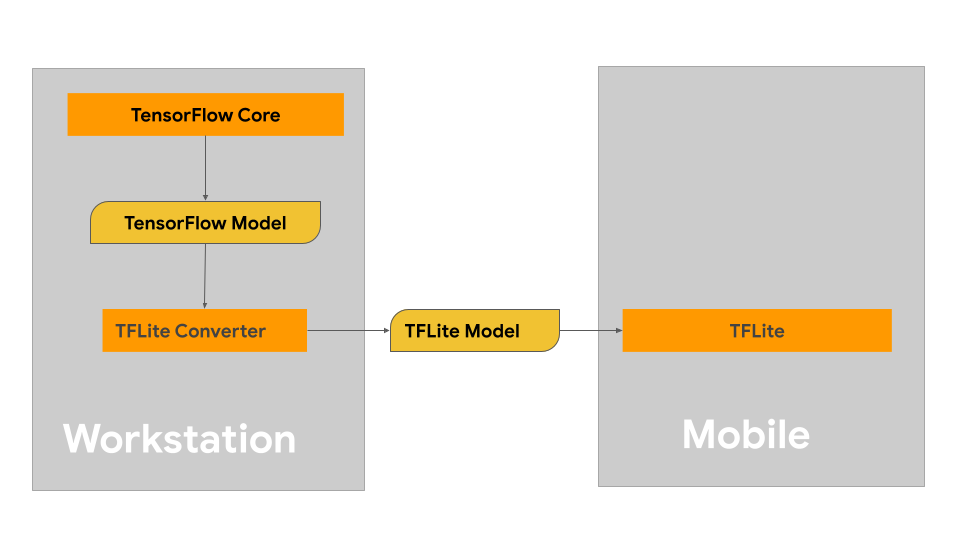This page provides guidance for building your TensorFlow models with the intention of converting to the LiteRT model format. The machine learning (ML) models you use with LiteRT are originally built and trained using TensorFlow core libraries and tools. Once you've built a model with TensorFlow core, you can convert it to a smaller, more efficient ML model format called a LiteRT model.
If you have a model to convert already, see the Convert models overview page for guidance on converting your model.
Building your model
If you are building a custom model for your specific use case, you should start with developing and training a TensorFlow model or extending an existing one.
Model design constraints
Before you start your model development process, you should be aware of the constraints for LiteRT models and build your model with these constraints in mind:
- Limited compute capabilities - Compared to fully equipped servers with multiple CPUs, high memory capacity, and specialized processors such as GPUs and TPUs, mobile and edge devices are much more limited. While they are growing in compute power and specialized hardware compatibility, the models and data you can effectively process with them are still comparably limited.
- Size of models - The overall complexity of a model, including data pre-processing logic and the number of layers in the model, increases the in-memory size of a model. A large model may run unacceptably slow or simply may not fit in the available memory of a mobile or edge device.
- Size of data - The size of input data that can be effectively processed with a machine learning model is limited on a mobile or edge device. Models that use large data libraries such as language libraries, image libraries, or video clip libraries may not fit on these devices, and may require off-device storage and access solutions.
- Supported TensorFlow operations - LiteRT runtime environments support a subset of machine learning model operations compared to regular TensorFlow models. As you develop a model for use with LiteRT, you should track the compatibility of your model against the capabilities of LiteRT runtime environments.
For more information building effective, compatible, high performance models for LiteRT, see Performance best practices.
Model development
To build a LiteRT model, you first need to build a model using the TensorFlow core libraries. TensorFlow core libraries are the lower-level libraries that provide APIs to build, train and deploy ML models.

TensorFlow provides two paths for doing this. You can develop your own custom model code or you can start with a model implementation available in the TensorFlow Model Garden.
Model Garden
The TensorFlow Model Garden provides implementations of many state-of-the-art machine learning (ML) models for vision and natural language processing (NLP). You'll also find workflow tools to let you quickly configure and run those models on standard datasets. The machine learning models in the Model Garden include full code so you can test, train, or re-train them using your own datasets.
Whether you are looking to benchmark performance for a well-known model, verify the results of recently released research, or extend existing models, the Model Garden can help you drive your ML goals.
Custom models
If your use case is outside of those supported by the models in Model Garden, you can use a high level library like Keras to develop your custom training code. To learn the fundamentals of TensorFlow, see the TensorFlow guide. To get started with examples, see the TensorFlow tutorials overview which contain pointers to beginning to expert level tutorials.
Model evaluation
Once you've developed your model, you should evaluate its performance and test it on end-user devices. TensorFlow provides a few ways to do this.
- TensorBoard is a tool for providing the measurements and visualizations needed during the machine learning workflow. It enables tracking experiment metrics like loss and accuracy, visualizing the model graph, projecting embeddings to a lower dimensional space, and much more.
- Benchmarking tools are available for each supported platform such as the Android benchmark app and the iOS benchmark app. Use these tools to measure and calculate statistics for important performance metrics.
Model optimization
With the constraints on resources specific to TensorFlow Lite models, model optimization can help to ensure your model performance well and uses less compute resources. Machine learning model performance is usually a balance between size and speed of inference vs accuracy. LiteRT currently supports optimization via quantization, pruning and clustering. See the model optimization topic for more details on these techniques. TensorFlow also provides a Model optimization toolkit which provides an API that implements these techniques.
Next steps
- To start building your custom model, see the quick start for beginners tutorial in TensorFlow core documentation.
- To convert your custom TensorFlow model, see the Convert models overview.
- See the operator compatibility guide to determine if your model is compatible with LiteRT or if you'll need to take additional steps to make it compatible.
- See the performance best practices guide for guidance on making your LiteRT models efficient and performant.
- See the performance metrics guide to learn how to measure the performance of your model using benchmarking tools.
